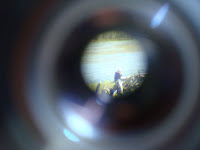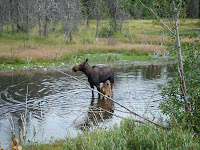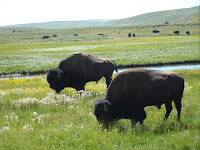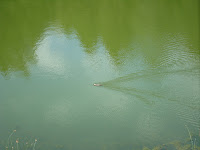(Note: Double click small size pictures, the full size photos will appear for better viewing of the far away animals)
During our trip at Yellowstone, we stayed outside the park at a hotel in the town of West Yellowstone - very close to the park's west entrance. It worked out pretty well as far as wildlife viewing and traffic was concerned. Getting in early in the morning (7am or so), leaving a bit late (~ 7pm) helped us to avoid traffic jams. Even though we drove about 30 miles of the same sections of roads every day, we actually had more chances for wildlife sightings. This might be one case that doing the same thing again and again we could expect different outcome.

The first day we entered the park from the west entrance in early morning, ~ 7am. About 10 miles into the park, we saw cars lined up by the side of road ahead of us. "Animals!" As we drew closer, we saw a large group of
deers on the hill slope by the road. Despite the frequent sighting of deers, we were still very excited since this was our first animal sighting at Yellowstone. As we were about to leave the area, one deer came down the hill and crossed the road in front of our car!

One day on the way out of the park, we saw another line up of cars by roadside, we slowed down, and there it was - a
red fox by the road side. We parked on the other side of the road, and observed and video taped the fox observing passers by, stretching its front legs, yawning and simply enjoying the late afternoon Sunshine.
Another day as we were on the road from one major area to another at noon time, we saw a lot of people standing by road side looking at an area with a few huge fallen trees. We were told by other onlookers that there was a
male adult moose under a big tree trunk. It took us quite a bit of time

to locate the moose which has a big antler. Someone must have really sharp eyes and excellent sense of moose to spot the good camouflaged animal under the fallen trees.
One time, there was an
eagle fishing in a river, frequently resting on a log. A ranger set up a telescope aiming at the log, so people who did not have good binoculars could see it. I took a picture of the eagle through the lens of the telescope!
It is great to see wildlife when someone else found it. It was much better and way more exciting and thrilling if we were the first one to spot a hardly found animal, such as the
grizzly bear and the
trumpeter swan. The key to wildlife viewing in such an large area is to be vigilant, to be alert and to be on the look out.
The mammoth spring was a big disappointment of our

Yellowstone trip because most springs were dormant that year. We went to a ranger educational program about the Yellowstone ecosystem there- which was interesting. At the end of the program, Lily asked the ranger about the best area to view gray wolf - a unique and controversial animal to the area. It was Lemar Valley - a 30 ~ 40 mile stretch to the east entrance of the park. We drove to the valley later that day. When we got there, there was not much to see - brown grass at the bottom of the valley, low grayish green bush buffered between the grass and pine trees further away, all the same along the stretch. We did see a couple of pick-ups parking along the stretch, old people with binoculars in hand waiting for gray

wolfs to show up - as the ranger told us. It was getting late, we turned around, and drove through the valley again, around 6:10pm (per time stamp on pictures), Lily spotted something moving along the seam between grass and bush, "Wolfs?" "
A pack of wolfs!" Justin confirmed via his binoculars. The three wolfs were walking along the seam in a line. How exciting! We were exuberant. We saw a couple of
bighorn antelopes in the same area, wishing to see wolfs to prey on them. Unfortunately, the wolfs were going in the opposite direction. We watched the wolfs until they disappeared into the bushes.
Be observant, and be patient would go a long way as well.

One time we saw a group of
pelicans swimming in a pond, a minute later a
bison walked slowly into the picture. Another time we were witnessing a bald eagle circulating over a hill, a few minutes later, a group of
white birds started following the
bald eagle! Yet another time, We observed a few
ospreys over a pond. Then one osprey starting to flap its wings, stayed stationary in the air, looking down, a few seconds later it dived into the pond - apparently to catch fishes. It was so fast, and so far away, it was really difficult to capture the actions on camera or video though we observed the dive several times.

Timing is hugely important as well.
In our second day at Yellowstone, we hiked along the beautiful and scene ever changing beavers pond trail. We saw a
pheasant on

the trail, a few seconds later, it disappeared into the woods. When reached the beavers pond, we saw a beaver dam and ducks in the pond but beavers were nowhere to be found. As we were about to continue our hike, I looked into the pond one more time and there it was, the elusive
beaver was swimming in the pond, actually from our side of the pond toward its house - the beaver's dam! This was our first ever sighting of beavers in their natural habitat.
Wildlife is not limited by the administrative boundary of the park. On our way to Jackson Hole Mountains, we crossed road again with hard to see wildlife - a mother moose and her 1 day old baby

(per a ranger who was monitoring the moose at the scene) were in a pond by the road. The innocent baby was only several yards away from us, it looked at our direction curiously until its mom called. We witnessed the feeding process as well as moose peeing!

For more common animals, such as
deers, elks, bison/buffalo on the ground, and
pelicans, gees, ravens, gulls in the sky or by the water, all you need to do is to be at the right places. On the beavers pond trail, we met a group of three couples of senior citizens, who told us they had not seen buffaloes - the common big mammals in the park! If you don't know where to see specific animals, ask a park ranger.
T

here are many
buffaloes in the park in the center east area - we saw hundreds of buffaloes at one valley, we saw tens of buffaloes crossing a road at fisherman's pier by Yellowstone lake.
Elks are very common as well, they might

rest in a meadow by a road in the early morning, they might walk in a river at noon time, or they might eat grass in late afternoon in a group.
Looking for wildlife is thrilling. Finding some on your own is exciting.

